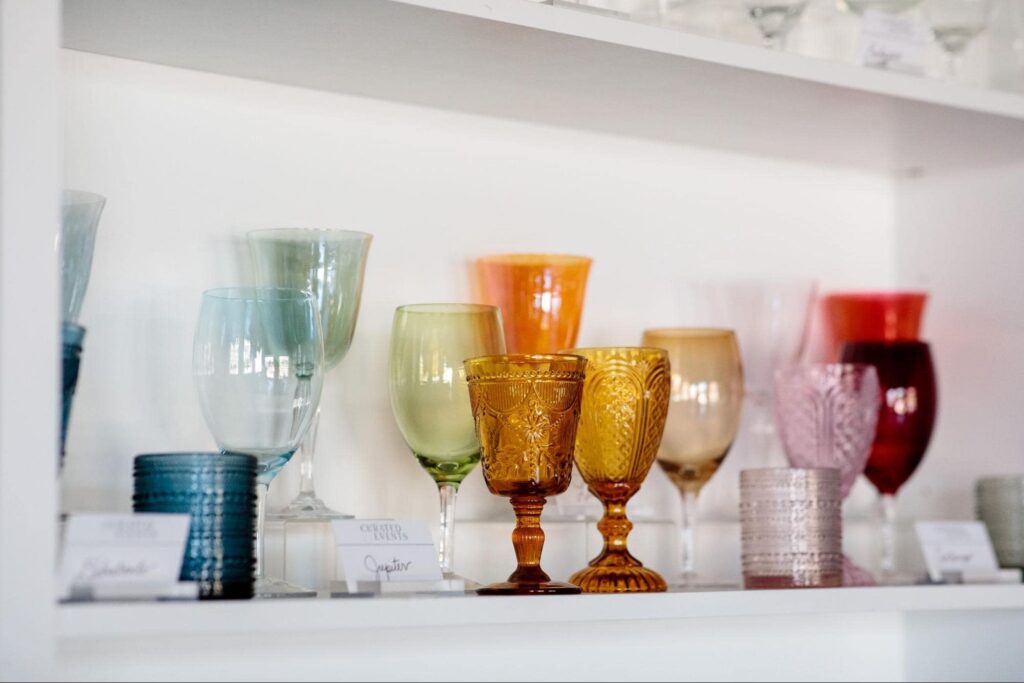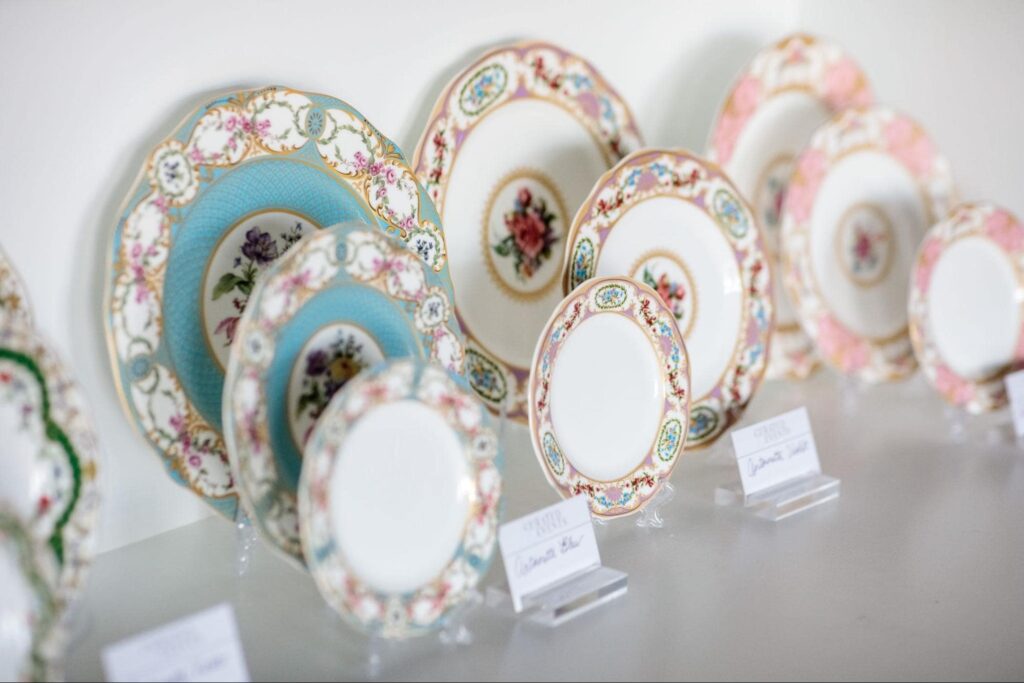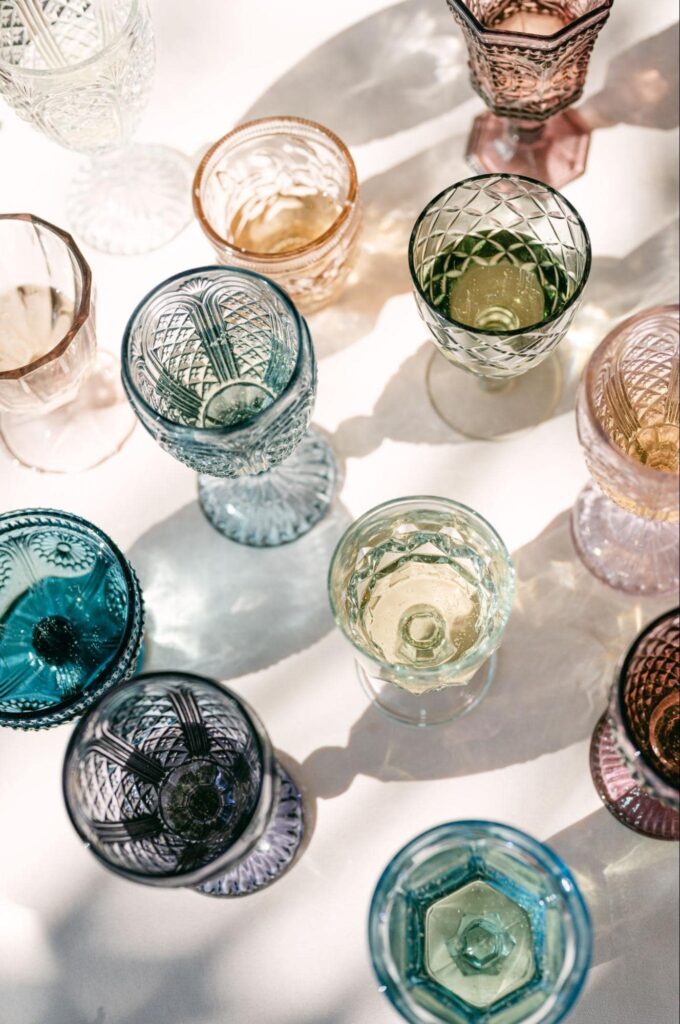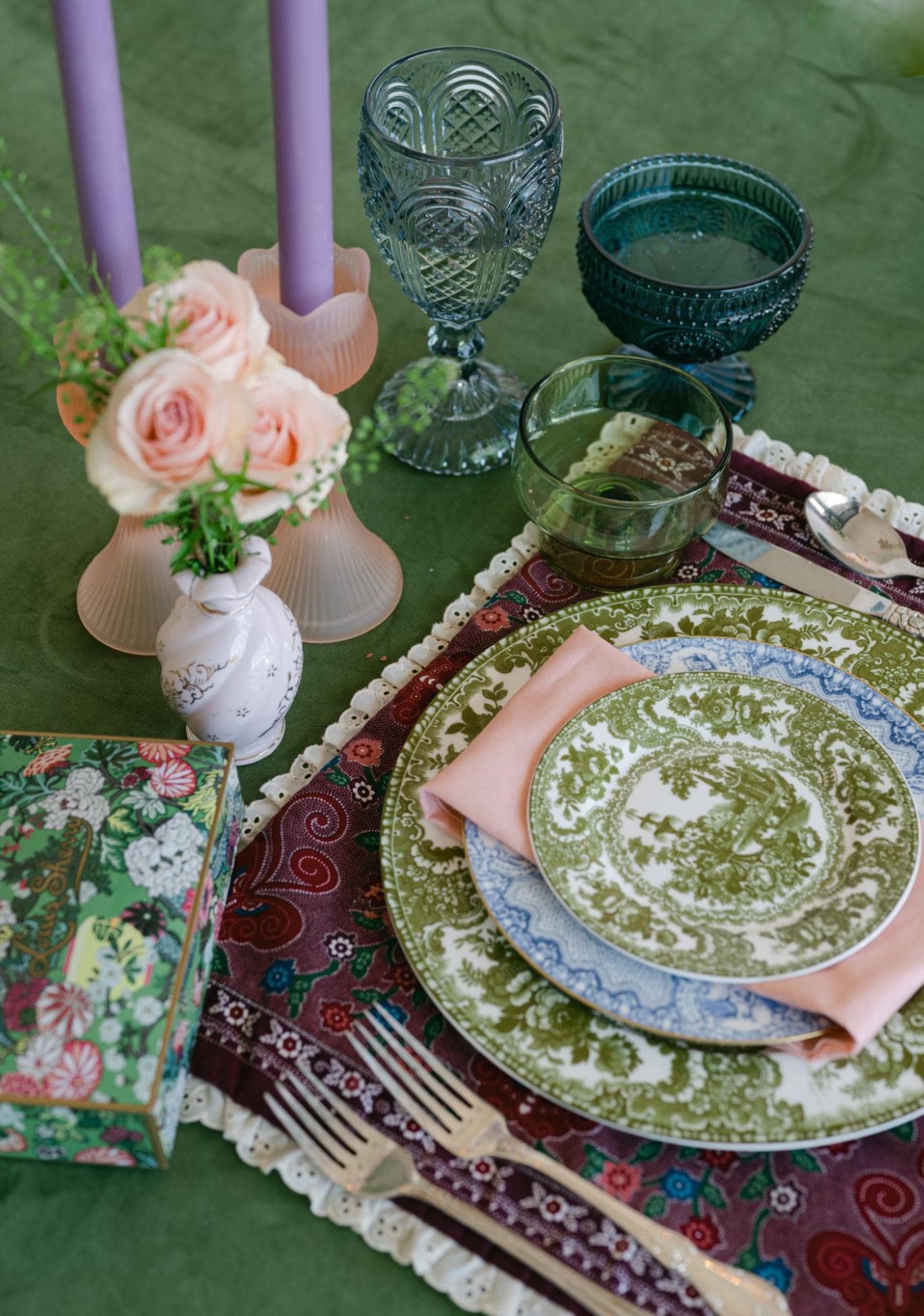Tableware includes the dishes, utensils, and drinkware used for serving and enjoying a meal. This covers items such as plates, bowls, cutlery, glasses, and serving pieces—each playing a role in the presentation and function of a dining setup.
Whether you’re hosting a casual dinner at home or planning a formal event, the tableware you choose helps set the mood and elevate the experience. In this guide, you’ll discover the main types of tableware, their specific uses, and tips for selecting the right pieces for any occasion.

What Is Tableware?
The term ‘tableware ‘encompasses all of the dishes, utensils, and vessels used in distributing and eating a meal. Also referred to as ‘crockery’ in the United Kingdom, these items come in sets that can be rented or bought for large gatherings involving food.
They play both a functional and decorative role, as aside from enabling guests to enjoy fare offerings, they also add visual interest to a dining table.
List of Tableware Items By Type
Choosing the right tableware starts with understanding what items are available and how each contributes to the overall dining experience. This list of tableware items is organized by category to help you plan with clarity and purpose, whether you’re hosting a formal dinner or a relaxed social gathering.
1. Dinnerware
Charger Plates – Decorative base plates placed beneath dinner plates to frame each setting.
Dinner Plates – The main plates used for serving entrees.
Salad Plates – Smaller plates for salads or appetizers.
Dessert Plates – Typically used for serving sweets after the main course.
Soup Bowls – Deep bowls designed for hot liquids and broths.
Bread and Butter Plates – Small plates used for rolls, butter, or condiments.
Cups and Saucers – Often used with tea or coffee service.
2. Serveware
Serving Platters – Wide trays used to hold and display main or side dishes.
Serving Bowls – Deep bowls used for shared items like salads or pastas.
Gravy Boats – Small vessels with spouts for serving sauces or gravy.
Butter Dishes – Keeps butter neat and easily accessible.
Sugar Bowls and Creamers – Common components of coffee or tea service.
Cake Stands – Elevated platforms that display desserts or centerpiece treats.
3. Flatware
Dinner Forks – Standard forks for main dishes.
Salad Forks – Slightly smaller forks used during appetizer or salad courses.
Dessert Forks – Designed for cakes, tarts, and other sweets.
Dinner Knives – Essential knives for general cutting and slicing.
Butter Knives – Dull-edged knives used for spreading.
Soup Spoons – Rounder, deeper spoons made for soups and stews.
Teaspoons – Smaller spoons ideal for coffee, tea, or desserts.
Serving Utensils – Large spoons, tongs, or ladles used to portion out shared dishes.
4. Glassware
Water Goblets – Large, durable glasses primarily used for water.
Wine Glasses – Available in styles for red or white wines, shaped to enhance flavor.
Champagne Flutes – Narrow, tall glasses ideal for sparkling wines.
Cocktail Glasses – Includes martini, highball, or rocks glasses depending on the beverage.
Beer Glasses – Ranging from mugs to pilsner glasses for serving different beer styles.
Stemless Glasses – Modern alternatives for wine or cocktails.
Coffee Mugs – Used for serving hot drinks like coffee or tea.
Getting To Know Each Type Of Tableware
Tableware is an extremely broad word that covers a litany of dishes and utensils. Generally speaking, items can be broken into four main categories: serve ware, dinnerware, silverware, and drinkware. The following sections will review each type’s role in the dining experience.
Serveware
Serveware, as its name suggests, is used for serving food. Anything that holds it or helps the distribution process can fall into this category, including serving platters, bowls, salad bowls, casserole dishes, soup pots, and teapots. Think of any item that you could use to present food to others.
While large dishes are usually the first thing that comes to mind when one thinks of serveware, certain utensils like serving spoons, tongs, ladles, and pitchers can also be considered part of the family.
Dinnerware
Sometimes called crockery or china, dinnerware is where food goes as it’s portioned to individuals. The category comprises any items used to eat directly, from dinner plates and soup bowls to salad plates, saucers, and dessert plates.

Types Of Dinnerware
Dinnerware can come in various sizes, shapes, and forms to suit different dishes. Let’s take a closer look at some common types and what context each is used in.
Dinner Plate – Used to hold main courses, this is one of the most common pieces of dinnerware you’ll come across. Dinner plates are the largest on the table, measuring 11 or 12 inches in diameter.
Dessert Plate – Dessert plates are saucers used to serve smaller portions of food. They measure 18 cm across and are best suited for informal gatherings that don’t involve a full sit-down meal.
Bread And Butter Plate – Sometimes referred to as a side plate or quarter plate, these pieces serve as accessories to main dinner plates. Bread and butter plates are smaller in diameter at roughly 15 cm and hold items like bread rolls, butter, and small condiments.
Appetizer Plates – Appetizer plates are slightly bigger than the average bread and butter plate, with a length of 17 cm or more. Simple and slightly curved, they’re meant to hold smaller portions of food or snacks before a full dish is served.
Soup Bowl – Holding up to 16 ounces of liquid, soup bowls can come in various shapes and sizes, depending on the type of soup served. Usually, they are round and measure between 11 and 12 cm in diameter.

The Materials You Can Find Dinnerware In
Aside from size and purpose, dinnerware can also differ in the material it’s made out of. You can find dishes in various options to suit any occasion – the following are some of the most popular.
Melamine – Melamine is a type of plastic that’s used to make dinnerware inexpensive and durable. It can be found in various colors and patterns, and is ideal for everyday use.
Porcelain – Porcelain dishes are made from kaolin and feldspar, resulting in a delicate yet strong material often used to make dinner plates and soup bowls.
Glass – Glass dinnerware is great for special occasions like weddings and corporate events, as it adds a sense of elegance to any table setting. Glass comes in various shapes and sizes, with transparent and colored options available.
Stoneware – Stoneware is usually found in earthy tones like cream and brown. It’s a heavy material that makes great dinner plates and soup bowls, and is ideal for outdoor use.
Earthenware – Earthenware is a type of pottery that’s been fired at low temperatures. It has a porous, matte finish and can be used to make various items, from cups to plates.
Silverware And Cutlery
Cutlery includes any implements used to eat food, from knives and forks to spoons and specialty utensils. This type of serveware can be made from various materials like stainless steel, silver, wood, and plastic.

Like dinnerware, cutlery encompasses many different sub-varieties, each of which can be used for a specific purpose.
Forks – are commonly used to spear, cut, and hold food on a plate. They come in varieties such as dinner forks, salad forks, and dessert forks.
Spoons – Spoons are used to scoop up liquid or solid food. They range from soup spoons to teaspoons, tablespoons, and finally, the dessert spoon.
Knives – Knives are used for cutting and spreading items such as butter and cheese. They have sharp blades and come in different lengths, from the small steak knife to the larger dinner knife.
The pieces that make up a cutlery set can differ depending on the occasion and menu, but typically you’ll find one of each type for an informal setting. From there, you can add more utensils as the occasion and complexity of dishes demand.
Drinkware
Drinkware comprises all items from which one can drink, such as cups, mugs, and glasses. As with dinnerware and cutlery, the drinkware you choose will depend on the occasion and menu.

Types Of Drinkware
There are countless varieties of drinkware out there, all of which can be broken down into two main categories: stemware and tumblers.
The first, stemware, refers to any glass with a thin and elevated base. Common examples include the martini glass, wine glass, brandy glass, Champagne coupe, cordial glass, Champagne flute, and Sherry glass.
Tumblers, on the other hand, look more like conventional cups and have a flat-bottomed design. The family includes glasses like tumblers, shot glasses, beer glasses, beer mugs, rock glasses, water glasses, Collins glasses, and tall glasses.
While the majority of drinkware that you’ll find at a formal event will be glass, several plastic and ceramic options are available for different budgets and beverage temperature levels.
Choosing The Right Tableware For Your Event
With all of the varieties out there, it can be difficult to know what type and style of tableware fits a particular event. These guidelines will help you discern what options make the most sense for your occasion.
Consider The Nature Of Your Event
The context of your gathering can help you determine the most suitable tableware to select. A casual outdoor barbecue will naturally call for more relaxed, picnic-style plates and cups, while a more formal indoor affair might require more structured pieces, such as traditional dinnerware or elegant china.
Think About The Number Of Guests
The number of people attending your event will also determine the type and amount of tableware you need. If you’re hosting a smaller gathering, you may want to opt for individual place settings. A buffet-style set up with shared plates and serving ware may be better if you expect a larger crowd.
Keep The Menu And Courses In Mind
When deciding on tableware, you’ll want to consider the menu. Multi-course meals will inevitably require more types of plates and utensils than small receptions. Formality comes back into play here as well; generally speaking, the more formal an event is, the more intricate you’ll want to get with place settings.
Tableware is only one piece of the puzzle when it comes to hosting a successful event, yet at the same time, it can be incredibly impactful. With the right combination of items and careful consideration for quality, style, and material, you can create a dining experience that exceeds expectations and leaves a lasting impression.
Frequently Asked Questions
What is the difference between Tableware and Flatware?
Tableware refers to any type of dish or plate used during a meal, while flatware is a collective term for cutlery (forks, knives, spoons, and other utensils).
Should I rent or buy Tableware?
Renting tableware is often the most cost-effective option for large events, while buying them is usually more practical for smaller occasions. Call on Curated Events for all of your table setting needs- it is our specialty!
What is tableware?
Tableware refers to the dishes, utensils, and drinkware used for serving and consuming food during a meal. It includes plates, bowls, cutlery, glasses, and serving accessories that contribute both function and style to the dining experience. Whether at a casual family dinner or a formal event, tableware plays a vital role in how a meal is presented and enjoyed.
What are the main types of tableware?
There are four main types of tableware: dinnerware, flatware, glassware, and serveware. Dinnerware includes plates and bowls used for individual portions. Flatware refers to eating utensils like forks, knives, and spoons. Glassware covers all drink-related items such as wine glasses and water goblets, while serveware includes larger items used to present and distribute food, such as platters, bowls, and pitchers.
What should be included in a list of tableware items?
A complete list of tableware items typically includes charger plates, dinner plates, salad plates, soup bowls, dessert plates, bread plates, forks, knives, spoons, water glasses, wine glasses, coffee cups, serving platters, and utensils. The specific list can vary depending on the type of event, menu, and service style. Having a clear list of tableware items ensures you’re well-prepared to create a polished and functional table setting.
Can I mix different types of tableware at my event?
Yes, mixing different types of tableware is a popular approach in modern event design. For example, you can pair rustic dinnerware with sleek metallic flatware or combine vintage glasses with minimalist plates. The key is to maintain a cohesive theme or color palette so the mixed elements complement one another without looking mismatched.
How do I choose the right tableware for my event?
To choose the right tableware, consider your event’s theme, formality, guest count, and menu. Formal events typically call for a full place setting with multiple courses, while casual gatherings may only require basic items. Reviewing a detailed list of tableware items can help you identify exactly what’s needed based on how your meal will be served.
Do I need different types of tableware for each course?
For formal events with multiple courses, it’s recommended to use different types of tableware for each stage of the meal—such as salad plates, soup bowls, dinner plates, and dessert plates. Each item is sized and styled for its specific use, helping to enhance the presentation and experience of the meal.


